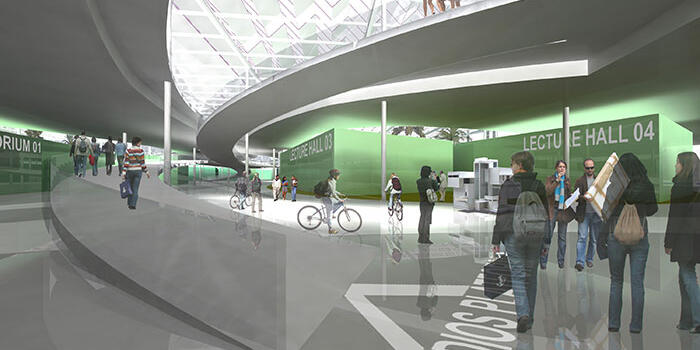Europe 40 Under 40 Awards Tell a friend
Ilham LARAQUI - France
Ilham LARAQUI is a young architect, an entrepreneurial woman who created at 30 years old LARAQUI BRINGER ARCHITECTURE with Marc BRINGER architect, in 2010 in Paris. Since then, the french agency has been celebrating many prizes and recognitions as listed below:
2009 - Prize-winner among 466 participants at the International Competition “Building for Bouwkunde” - Faculty of Architecture, Urbanism, landscape, Design and Building Sciences of the TU-Delft (Netherlands) – “Green Housed Culture”.
2009 - Prize-winner of the European Competition of Architecture and Urbanism: EUROPAN 10 - Seilh / “Fields of Possibilities”. The competition gathered 2,429 architects aged less than 40 years.
2010 - Prize-winner of the session 2009-2010 Album of Young Architects and Urban Planners known as AJAP, delivered by the French Ministry of Culture. The competition gathered 242 agencies, owned by architects under 35 years.
2011 - Winner of 2 different public competitions in close suburb of Paris: Chaville and Saint-Ouen.
2013-2015 - Management and Delivery of both buildings: Saint-Ouen’s Social Clubs and Citizen's House and Chaville’s Cultural & Leisure Centre.
2015 - Prize winner of “PRO-BTP Awards” - ECL of Chaville.
Project Description
The design brief for the Faculty of Architecture, Urbanism and building Sciences at TU DELFT, listed optimum daylight usage, a sustainable and low-resources energy concept, flexible usage and the use of natural-based materials as the governing criteria. The glass enclosure of the Faculty is developed with a footprint of 32 000 m² as a “microclimatic envelope” for passive solar energy gains, beneath which the various parts of the facility are accommodated as separate units. Photovoltaic glass modules cover about half of the industrial roof surface (12 000 m²) and are integral components in the design concept; apart from generating electricity, they also provide sun shading and control the amount of incoming daylight. The faces looking North are entirely glazed, which allows all the workshops to be suffused with natural light, thus saving on artificial lighting.
In order to produce a “clouds effect”, the modules were installed in different densities. Opening lights above the planted patios act as vents. The protection from the weather and the solar energy gains result in a controlled atmosphere, which makes the glass enclosure usable as a large internal space and reduces the energy requirements of the buildings within it. The warm air that builds up beneath the glass roof can be used to save additional heating energy in winter. The load bearing structure and façade construction are mostly in wood, a renewable resource. The sustainable concept also includes the collection of rainwater in large pools integrated in all the green patios. These pools are fitted with underground tanks acting as overflows. The stored water is used for the sanitation system, the usual maintenance of the building and the generous watering of the plants and flower beds laid out in the patios and around the building.
Special care has been taken of the various ways people move around inside the Faculty, with always a view to cutting down on consumption and waste production. The building, horizontally laid out, extends up four levels, which encourages people to walk or cycle at ground level. Bicycle stand areas are available near the entrances to the building and all along the interior walkways whose curved shapes make for greater fluidity in comings and goings. Putting a premium on stacking rather than spreading the project limits the surface area devoted to car parking thanks to a winding car park fitted in the largest patio in the complex.
The Faculty is designed as an inhabited greenhouse. It sets out to be a paragon of environmental virtues, the new icon of sustainable development paradigm. This giant greenhouse is home to a wild vegetation rather like botanical gardens and generates architectural, urban and landscaping culture. Unlike greenhouses that are used to mass-produce plants and vegetables off-ground, it lets nature grow and sink the platform of studio flats, move the ground-floor buildings about, generating an entropic space that could look like the one outlined by Yona Friedman in his utopian work entitled “For scientific architecture”:
« Effective erratic configurations » are assembled in a way where every step is a completely random one. Labyrinths imply effective erratic space; each step in the process of building a labyrinth is followed by one that is not determined by the preceding one. Proteinic space-chains are such labyrinths, and probably belong to most erratic configurations one can imagine, disorienting for both the maker and the spectator at the same time. »
The project proposes a programme divided into two large platforms : the first on the Ground Floor is taken up by space functions shared by all the Faculty students and visitors. These programmes are broken down into units laid around planted patios. Each programmatic unit is made up of container buildings of varying sizes and apparently random patterns. The units can be identified by their colour code and by the special plant species grown in their patios. Most of the programmes located on the ground floor take up two storeys. The second major platform gathers all the studios of the Faculty, thus encouraging exchanges between generations and between the various disciplines of the BOUWKUNDE. The studio platform is entirely covered over by the great shed roof. Offices, meeting rooms and utility premises are freely laid out as small standard two-storey buildings.


















